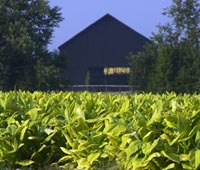Knowing Tobacco Production Costs
Knowing Tobacco Production Costs

As tobacco producers enter a new world of production without a federal tobacco program, knowing how much it costs them to produce the crop will be key in determining if they can be successful.
To help farmers determine their production costs and to better understand other aspects of the post buyout era, economists with the University of Kentucky College of Agriculture are conducting meetings across the state this winter. One of the first was conducted at the Daviess County Extension office and attracted a large number of producers.
“We wanted to try to bring them some tools that they can take home and look at their own production history and evaluate what it has been costing them per pound to grow tobacco,” said Clint Hardy, Daviess County Extension agent for agriculture and natural resources.
There are a number of decisions that growers are going to face immediately and over the next two to five or 10 years, said Steve Isaacs, UK Extension agricultural economist. The first will be whether to continue to grow tobacco. UK has an interactive worksheet to help people determine their cost of production along with a series of other information on its Tobacco Economics Online Web site.
“We have had a real interesting thing happen in tobacco production for 60 years or so because most folks didn’t need to know what the cost of production was going to be because most farmers were going to make money at it,” he said. “It has been a profitable enterprise. But now with essentially a 45- to 50-cent per pound drop in price, then it’s a little bit more problematic. The economics of tobacco have become a lot more acute.”
Labor is the biggest expense farmers have in producing tobacco, making up about 50 percent of the total cost. Yet, Isaacs noted that few farmers know how many labor hours they have in an acre of tobacco.
“If you are producing burley tobacco with less than 200 hours of labor per acre, you are flying,” he said. “That’s all labor, not just hired labor. That’s yours and any family labor. Those labor hours are going to be critical in estimating cost of production because unless you are hiring it all, that is going to be a cost that you need to be paid for. You need to value your time; you could be working for someone else. Your labor is worth something.”
During the meetings, Isaacs reviews the budgets with farmers to illustrate how they can use their own numbers to determine what their production costs total and what they will need to be profitable.
Another key in the budgeting process is the quantity of pounds farmers produce.
“Production costs are driven by yield,” Isaacs said. “In tobacco production, there are very few costs that change with yield. The stripping cost may be the only one if you are paying by the pound otherwise a 1,800-pound tobacco crop will have about the same amount of fertilizer, same amount of transplants and labor in it as a 2,800-pound crop of tobacco. If it is labor on a per hour basis, it really doesn’t change that much because every plant has to be handled whether it yields two-tenths of a pound per plant or four-tenths of a pound per plant.”
Isaacs said tobacco production will go to low-cost producers.
“The people who are going to have an advantage in this market are those who can produce it at a low cost per pound and generally that will be those who can produce relatively high yielding tobacco whether they’ve got two acres or 200 acres,” he said. “The other thing that this brings out is that people who have their own land, machinery, barns and family labor have a lot of staying power in this market. To me it is a bit of a myth to say there won’t be any small growers.”
Longtime Daviess County tobacco farmer Bill Kuegel noted at the meeting that few farmers have worked on making their tobacco operations as efficient as they could be. Under this new marketing system, being efficient will be vital to lower production costs while maintaining high yields.
Additional issues farmers will have to consider in the post buyout era are leasing arrangements, Isaacs said. Farmers and landowners will need to redefine share leases in light of landowners losing the quota which was the primary input they had into the share. Other issues facing farmers and quota owners include deciding whether to take quota payments over the 10-year period or as a lump sum and how to invest those payments.
For more information on tobacco issues, contact a county Cooperative Extension Service office.